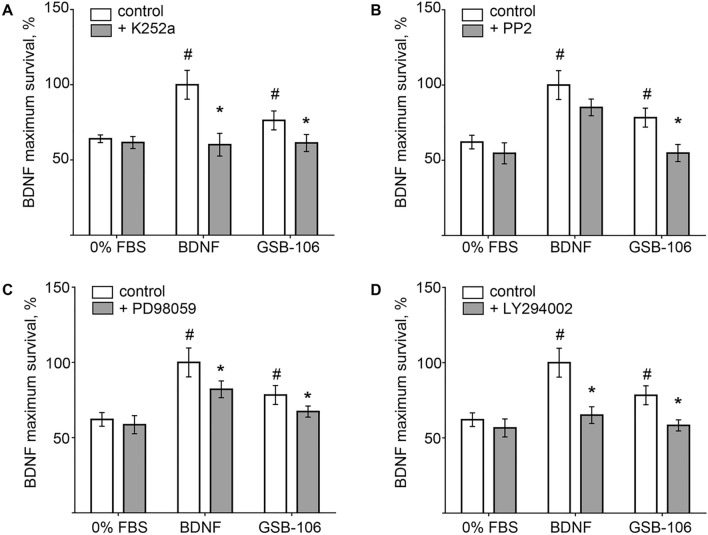Figure 2.
GSB-106 promotes survival of serum-deprived SH-SY5Y cells through TrkB and downstream signaling pathways. (A) Survival analysis of serum-deprived SH-SY5Y cells (2 × 105/well) incubated with BDNF (1 nmol), GSB-106 (100 nmol) in the presence of K252a (500 nmol) for 48 h. Cell viability was normalized to viability in BDNF group (n = 5; #p < 0.05 in relation to 0% FBS-control; *p < 0.05; in relation to agonist without inhibitor; Wilcoxon t-test). (B) Survival analysis of serum-deprived SH-SY5Y cells (2 × 105/well) incubated with BDNF (1 nmol), GSB-106 (100 nmol) in the presence of PP2 (100 μmol) for 48 h. Cell viability was normalized to viability in BDNF group (n = 5; #p < 0.05 in relation to 0% FBS-control; *p < 0.05; in relation to agonist without inhibitor; Wilcoxon t-test). (C) Survival analysis of serum-deprived SH-SY5Y cells (2 × 105/well) incubated with BDNF (1 nmol), GSB-106 (100 nmol) in the presence of PD98059 (50 μmol) for 48 h. Cell viability was normalized to viability in BDNF group (n = 5; #p < 0.05 in relation to 0% FBS-control; *p < 0.05; in relation to agonist without inhibitor; Wilcoxon t-test). (D) Survival analysis of serum-deprived SH-SY5Y cells (2 × 105/well) incubated with BDNF (1 nmol), GSB-106 (100 nmol) in the presence of LY294002 (1 μmol) for 48 h. Cell viability was normalized to viability in BDNF group (n = 5; #p < 0.05 in relation to 0% FBS-control; *p < 0.05; in relation to agonist without inhibitor; Wilcoxon t-test).

